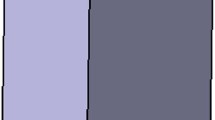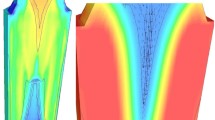Abstract
Discrete element method (DEM) has been applied to the mining and mineral processing simulations since 1990s. Successful applications include simulations for conveyor transportation and transition, screen size separation, crusher crushing process, SAG/AG and ball mill operations and associated liner wears, flotation process, and etc. In these DEM applications, particle sizes change from micron scale to meter scale and solid fractions vary from <10 % to almost 100 %. Therefore, it is challenging to use DEM to address different types of scale problems. To meet the challenge, various types of DEM technologies and some special types of particle-based computational mechanics methods have been developed to treat various types of applications. In this paper, it is shown that the mining and mineral processing application domain can be divided into nine subdomains and almost each subdomain requires a specialized DEM methodology or a particle-based computational mechanics method. Examples are given to demonstrate the specialized DEM applications.
Access provided by CONRICYT-eBooks. Download conference paper PDF
Similar content being viewed by others
Keywords
1 Introduction
Every process in mining and mineral processing engineering is associated with a particular range of particle size distribution and a particular range of solid fraction. It is a common knowledge that DEM applications are subjected to the limitation of medium particle size because DEM cannot handle situations where majority of particles are fine particles. However, not many DEM users realize that DEM applications are also subjected to the limitation of solid fraction.
Let us observe an experiment of a packed bed of particles subjected to slow compression (see Fig. 1). The loading process can be divided into 3 regions as below.
-
(1)
Region 1: the volumetric strain is below 0, which corresponds to a range of solid fraction under 0.64.
-
(2)
Region 2: the volumetric strain is between 0 and 0.2, which corresponds to the range of solid fraction from 0.64 to 0.8.
-
(3)
Region 3: the volumetric strain is between 0.2 and 0.35, which corresponds to the range of solid fraction from 0.8 to 0.98.
In general, in region 1, most commercial DEM package can perform simulations well. In region 2, particles will experience breakage and thus only those specialized DEM technology with capability of breaking particles can perform a simulation. In Region 3, DEM cannot perform a normal simulation at all because particles become very fine, the range of particle size distribution becomes very wide, and the Poisson effect is not negligible.
Combining the knowledge of DEM application limitations associated with medium particle size and solid fraction, we can divide the major domain of mining and mineral processing applications into 9 subdomains as shown in Fig. 2. In Fig. 2, the green zoon is the subdomain, where the DEM can perform its normal duty; the yellow zones are the subdomains, where specialized DEM technologies are required to address their specific scale problem; and the red zones are the subdomains, where DEM cannot play a major role and other types of computational mechanics methods such as CFD, FEA and MPM have to be employed.
In the following section, we will discuss suitable computational technologies in the yellow and red subdomains of Fig. 2.
2 Special DEM Technology and Applications
As mentioned in the previous section, DEM applications are subjected to limitations of medium particle size and solid fraction. In the green subdomain, most DEM programs especially those commercial DEM software package can comfortably be employed to perform simulations. However, in the yellow and red subdomains, care must be taken or significant modifications in DEM algorithms must be made in order to perform suitable applications. Here we only address a few issues raised in dealing with the limitations of medium particle size and solid fraction.
2.1 Determination of Cut-off Particle Size
In yellow subdomains of Fig. 2, the cut-off particle size has to be determined in order to carry out a DEM simulation. Once the cut-off particle size is determined, all the masses of particles less than the cut-off size will be lumped into the particles of the cut-off particle size. If the cut-off particle size is too small, the resultant number of particles in the model will exceed the limit of computer memory capacity and the time step will be too small to complete a simulation in a reasonable time frame. Thus a rule of convergence regarding the selection of the cut-off particle size in DEM simulations must be established. In general, for a given type of application, one can test several different cut-off particle sizes, compare the simulation results and then find out the optimal cut-off particle size for a particular DEM application. As an example, let us consider the simulation of AG mill polymet liner wear. The description of combining wear mechanism with DEM program to simulate mill liner wear can be found in [1]. Here we try to use the 6.7 m AG mill liner wear measurement data to calibrate the DEM wear model and then predict the wear life of a different polymet liner for an 11.6 m AG mill under the given condition that the particle size distributions inside of both AG mills are the same. During the calibration process, four different cut-off particle sizes, 25 mm, 35 mm, 45 mm and 70 mm, are used respectively in the DEM model of the 6.7 m AG mill. Figure 3a shows the influence of cut-off particle size on the convergence of the calculated results of curves of liner lifter height vs time. It is seen from Fig. 3a that as the cut-off particle size is equal to or kept less than 35 mm, stable numerical results are guaranteed. Also, it is seen from Fig. 3b that by using the 35 mm cut-off particle size, the simulation results can perfectly match two measured wear profiles. However, it is seen from Fig. 3c that by using the 70 mm cut-off particle size, the simulation results cannot simultaneously match two measured wear profiles. This indicates that the numerical results corresponding to the use of 70 mm cut-off particle size fail to meet the so called time-proportionality criterion, which serves as one of the fundamental principles in DEM simulation of wear process described in [1]. Therefore, along with a set of calibrated wear parameters, we choose 35 mm as the cut-off particle size for the DEM simulation to predict the wear process for the 11.6 m AG mill polymet liner. Figures 3d–f show the predicted history of liner wear for an 11.6 m AG mill (used in the same mine) compared with measurements. It is seen that the predictions match the measurement data within the engineering tolerance of accuracy.
a Influence of cut-off particle size on the convergence of simulated liner wear history. b 6.7 m AG mill liner wear profiles using 35 mm cut-off particle size. c 6.7 m AG mill liner wear profiles using 70 mm cut-off particle size. d Particle motions in 11.6 m AG mill. e 11.6 m AG mill liner wear profile compared with measurements. f 11.6 m AG mill liner lifter height versus time
Our experiences also show that for vibration screen applications, the optimal cut-off particle size is about 1/3 of the screen aperture size, and for crusher applications, the optimal cut-off particle size is about 1/2 of the close-side setting.
In the red subdomains of Fig. 2 corresponding to fine medium particle size, the number of particles in the model significantly exceeds the limit of computer capacity and DEM can no longer play the major role in simulations. Thus other methods such as CFD may play a leading role in simulations. However, sometimes DEM can still provide useful results in the form of one-way coupling by tracking the motions of a small group of particles after obtaining the solution of fluid field.
2.2 DEM Technology Dealing with Medium and High Solid Fractions
In cases where the solid fraction falls in the range between 0.64 and 0.8 (corresponding to two yellow subdomains in Fig. 2), the conventional DEM technology cannot provide useful results and modifications are necessary. The major ingredients in the modified version of DEM program are listed as below.
-
1.
The DEM program must include the mechanism of particle breakage. For this purpose, polyhedral particles are used and a numerically efficient method called fast breakage algorithm to break a polyhedral particle is introduced in DEM program [2]. This algorithm employs the Markov stochastic equation as the constitutive law for particle breakage and fragmentation.
-
2.
The DEM program needs a more efficient contact search algorithm to handle situation of very large ratio (30–100) of the largest particle size to the cut-off particle size. The recommended algorithms include the algorithm using multiple search grids for different sizes of particles or the algorithm using single grid with flexible grid size.
-
3.
The DEM program requires an accurate algorithm to account for contact force and deformation relationship including damping mechanism.
Figure 4 shows the results of simulated operation of a cone crusher. It is seen that the DEM program with the above mentioned ingredients can accurately predict the power draw, throughput and product size distribution.
In cases where the solid fraction falls beyond 0.8 and particle medium size become very fine (corresponding to the red subdomain in the top-left corner of Fig. 2), the above mentioned DEM program even with the capability to break particles can no longer provide useful solution. Typical examples include the simulation of the operation of high pressure grinding rolls. In such situation, the ore particles are crushed, compressed and squeezed into a thin sheet of plastic continuum (called cake). The best numerical methods to treat plastic continuum are particle based methods such as SPH and MPM methods.
Figure 5 shows the results of numerical simulation for an 800 mm diameter high pressure rolls using plastic model. It is seen that the numerical results of power draws and force-gap relationship well agree with measurements.
3 Conclusions
In DEM simulations for mining and mineral processing applications, the DEM application domain can be divided into nine subdomains. Due to the large variation of particle size and solid fraction, DEM method has to be modified according to the requirements related to different subdomains. The requirements for the DEM ingredients in some subdomains are discussed. Examples are given to demonstrate the applications in some particular subdomains.
References
Qiu, X., Potapov, A., Song, M.: Prediction of wear of mill lifters using discrete element method. In: Mular, A. (ed.) SAG 2001, Vancouver, BC, Canada (2001)
Potapov, A., Herbst, J.A., Song, M., Pate, W.: A DEM-PBM fast breakage model for simulation of comminution processes. In: The 4th International Conference Discrete Element Method, Brisbane, Australia. Elsevier 2009 (2007)
Author information
Authors and Affiliations
Corresponding author
Editor information
Editors and Affiliations
Rights and permissions
Copyright information
© 2017 Springer Science+Business Media Singapore
About this paper
Cite this paper
Qiu, X. (2017). DEM Simulations in Mining and Mineral Processing. In: Li, X., Feng, Y., Mustoe, G. (eds) Proceedings of the 7th International Conference on Discrete Element Methods. DEM 2016. Springer Proceedings in Physics, vol 188. Springer, Singapore. https://doi.org/10.1007/978-981-10-1926-5_5
Download citation
DOI: https://doi.org/10.1007/978-981-10-1926-5_5
Published:
Publisher Name: Springer, Singapore
Print ISBN: 978-981-10-1925-8
Online ISBN: 978-981-10-1926-5
eBook Packages: Physics and AstronomyPhysics and Astronomy (R0)









